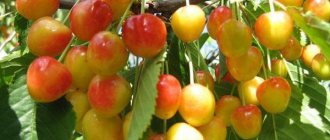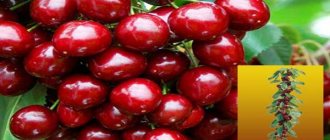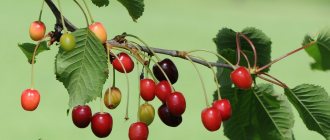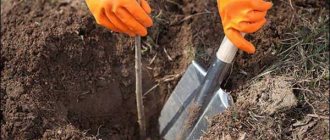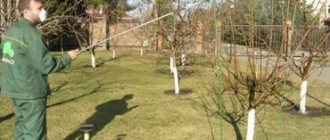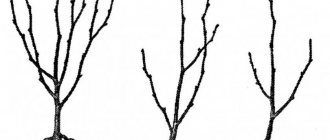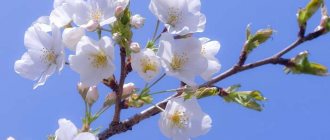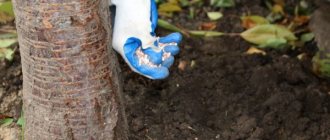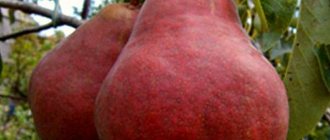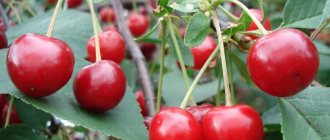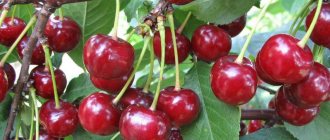Description of columnar cherries
Columnar cherry trees are formed in the shape of a cylinder. The crown grows upward, the side branches are cut off, forming a column a meter in diameter.
What does a columnar cherry look like?
The plant is small in volume. The crown circumference is one meter, the height of the columnar cherry is 2-3 meters. The plant is strewn with berries and has few leaves.
Columnar cherry root system
The roots are of sufficient depth, but they do not expand beyond the crown.
Productivity
Each plant provides 15 kg of berries depending on the type. Cherries cover the trunk, making it look like an ear of corn.
Resistance to diseases, pests, frosts
The culture loves warm climates. The southern and central regions of Russia are suitable for her. In northern latitudes, you should take care of winter shelter.
Breeders give varieties immunity to diseases and pests. There are still cases of damage by coccomycosis and insects.
How to plant Columnar cherries
Despite the unpretentiousness of columnar cherry varieties, in order to fully develop and obtain a good harvest, a number of agrotechnical measures for planting and further care must be observed. For placement, select a sunny area, with protection from through winds and with light shading from the midday heat. The soil is preferably loose and fertile, with distant groundwater flows.
Important! It is recommended to plant the plant on slight elevations facing south.
How to choose a seedling
You need to buy seedlings in specialized gardening stores or nurseries. Sales through Internet resources are no less popular now. The latter method is less reliable, since there is no way to visually familiarize yourself with the purchased varieties in advance.
When purchasing columnar cherry seedlings, they are guided by a number of factors:
- The presence of living and uninjured ovaries on the apical part of the shoot.
- Smooth trunk without any deformation.
- The presence of rot and growths on the root system of columnar cherries is unacceptable.
- Foliage, if present, must be consistent with the age of the seedling and show no signs of disease.
Important! For planting, seedlings of the same age are purchased.
Planting dates and scheme
The timing of planting Colonoid cherry seedlings varies, which is influenced by location: in the north - in spring, in the south - in autumn. Late planting is predicted several weeks before the first cold snap, spring planting - after warm weather sets in.
How to plant columnar cherries in spring or autumn:
- Dig a hole of the appropriate size so that the roots are not crowded in it.
- They correctly determine at what distance to plant columnar cherries - the permissible limit is 2-3 meters. The interval between rows is 1.5 m.
- Place the cherry seedling in a hole, having previously treated the rhizome with clay mash, and cover it with soil. The root collar is left open 2-3 centimeters above ground level. Otherwise the tree will die.
- Upon completion of planting work, the seedling is abundantly moistened.
- Dig shallow grooves in the root space to make future watering more convenient.
Advice! It is advisable to immediately dig in vertical supports nearby and secure the plantings.
Pit preparation
The hole is dug to approximately a depth of 80. The diameter is selected to suit the root system so that the shoots fit without creases. If groundwater is close to the ground, drainage is laid out at the bottom of the hole: expanded clay, brick chips. A soil mixture is poured into the center in a heap, which is prepared in advance: humus and black soil, in a ratio of 1:3. Potassium and phosphorus fertilizers of 17 and 12 g are added to them.
Columnar cherries: description of varieties with photos
This plant is less recognized in Russia than apple and pear trees. There are varieties that are grown in different regions of the country depending on their quality.
Popular varieties of columnar cherries:
- Helena;
- Silvia;
- Sam;
- Queen Mary;
- Black;
- Little Sylvia;
- Revna;
- Sabrina.
Below are their characteristics.
Helena
Dessert, bright red berries, weight 2-14 g. The tree is tall, up to 3.5 meters, the crown is a meter in diameter. A high-yielding species, it bears fruit from June 15-20 for a week. Continues to bear fruit for up to 20 years.
Silvia
Similar in characteristics to Helena. The size of the tree and fruit, yield and taste are the same. Selena has an early ripening period - from June 12-18. She has a shorter fruiting period - 15 years.
There is a variety called Little Sylvia with a height of no more than 2 m.
Below is a photo of the red columnar Sylvia cherry.
Sam
The earliest variety. It becomes ripe before June 12, the weight of the berries is 12 g, the fruiting period is 15 years. Serves as a pollinator for different varieties of this crop.
Queen Mary
Dessert, not too cold-resistant. Grown in the middle zone. The annual harvest is 15 kg.
Black cherry
Columnar black cherries are famous for their high yields, large berries and frost resistance. Unpretentious appearance, compact, no higher than 2 meters.
Revna
She has sweet juicy berries. They are well stored and transported. Frost-resistant variety. Disadvantage - smallish berry - 8 g. Ripens in early July.
Sabrina
This is a self-pollinating columnar cherry. Tall voluminous tree. Yield variety, sweet berries. Cold resistance is low. Good immunity to diseases and pests.
Characteristics
Columnar cherries have the following characteristics:
- An adult tree does not grow higher than 3 meters. The average size of the crop is 2 meters.
- The branches do not grow in width, and the diameter of one seedling is no more than 1 meter.
- The first harvest is harvested 3 years after planting.
- The life cycle of a tree is 20, and in rare cases, with good care, 30 years.
- It has an impressive yield - on average, 13 kilograms of cherries are harvested from a tree.
- The variety is distinguished not only by the pleasant taste of the fruit. The fruits are rich in vitamins and minerals of various groups.
Resistance to drought and frost
Columnar cherries have average frost resistance and are suitable for growing primarily in regions with a warm, mild climate. Of course, the crop is also planted in regions with cold climates, but in this case the gardener will have to spend more time and effort on growing and caring for it.
The tree does not like excessive dryness, but do not overdo it by flooding the seedlings with large amounts of water. It is optimal to water with a moderate amount of water, which is increased only during particularly dry periods. Gardeners can also slightly increase the amount of water when watering during fruit set.
Pollination, flowering period and ripening
For crop pollination, the Sem variety would be a good choice. It is a kind of universal pollinator that goes well with other popular varieties. For pollination of the Sem variety, the following varieties are suitable:
- Van Big;
- Helena;
- Hedelfinska.
The Cordia and Silvia varieties also grow well together.
The flowering period of cherries is late, but due to the resistance of flowers to low temperatures, they can withstand frosts down to -2 o. Most varieties ripen in June, closer to the middle of the month, approximately on the 15th.
Yield quantity and taste of berries
Cherry has a high fruit yield and begins to bear fruit already 2-3 years after planting. Experienced gardeners who have been growing this crop for several years recommend removing all ovaries that form on the tree in the first two years after planting on the site. This will allow new seedlings to take root on the site and subsequently produce a stable, high-quality harvest.
Young trees bring the owner, on average, about 14 kilograms of fruit from one seedling.
Adult specimens can produce a harvest of up to fifty kilograms of cherries. Such intense fruiting negatively affects the lifespan of cherries. Most trees live no longer than 20 years. The fruits of the tree have a pleasant, rich taste that can compete on equal terms with other varieties.
Immunity to diseases and pests
Susceptible to the following diseases:
- scab;
- brown spot;
- tinder.
If signs of these diseases are detected, the affected leaves are torn off, after which the tree is treated with Bordeaux mixture.
See also
Description and characteristics of the Veda cherry variety, cultivation and careRead
The crop is vulnerable to attack by pests such as:
- aphid;
- weevil;
- caterpillar;
- codling moth.
To destroy harmful insects, treat the tree with special preparations.
Important! To prevent the appearance of pests, treat the tree trunk with a solution of slaked lime. It is necessary to paint from the base, approximately 40-50 centimeters upward.
Varieties of columnar cherries for regions
To wait for the berry harvest, you need to choose the right variety for the place where it is grown. The main thing is its frost resistance and the period for picking berries.
Important! For regions with early cold weather, late-ripening varieties are not planted.
Columnar cherries for the Moscow region
Suitable varieties are sufficiently frost-resistant, with low requirements for growing conditions. This is Sam, Sylvia, Helena, Chernaya, Revna.
Varieties of columnar cherries for Siberia
Cold-resistant varieties Revna and Chernaya are planted in Siberia. They are immune to disease and are rarely attacked by pests. In this region, columnar cherries should be planted in the spring.
Columnar cherries for the Urals
The climate in the Urals and Siberia is quite similar, so they choose the same varieties - Revna and Chernaya.
Which varieties of columnar cherries are suitable for central Russia
The varieties grown here are not very cold-resistant, but at the same time quite unpretentious.
This is Sabrina, Queen Mary, Little Sylvia.
Yellow columnar cherries bear fruit abundantly.
How and when to plant cherries
The time for planting cherries depends on the region where you live. If you live in the southern regions, with a warm climate favorable for growing, the tree can be planted in both spring and autumn. In cold areas, the situation is more complicated, and a seedling planted in the fall may not have time to gain a foothold before frost, which is why it will die in the future.
Therefore, in such conditions, it is recommended to plant young shoots in the spring, when the temperature at night stabilizes and becomes above zero - this is the best time for cultivation.
Columnar cherries: planting and care
Can be planted in spring or autumn.
Advice! In the Moscow region, it is better to do this in the spring for successful rooting of seedlings.
Planting columnar cherries in spring
Rules for planting columnar cherries in spring:
- The best place would be a flat area, not shaded by buildings or tall plants. Low swampy places with close groundwater are not suitable.
- The soil required is sandy loam, fertilized with humus, with low soil acidity. Add lime or dolomite flour to acidic soil.
- Make holes 50 x 50 x 60 cm, with a mound of fertile soil in the center. A seedling is placed on a mound with its roots spread out.
- The roots are covered with soil and watered. The surface is mulched to avoid crust formation. Columnar cherries are planted at a distance of one and a half meters. Adjacent rows are spaced three meters apart.
Growing columnar cherries
Caring for columnar cherries is standard for fruit trees. Basic fertilizing is done twice a season. The first is done at the end of March with dry fertilizers on the snow. Apply complete complex fertilizer. In August, fertilize with mixtures that do not contain nitrogen.
Watering is important. This plant requires a lot of water to produce berries. It is important to monitor the condition of the soil around the tree. To retain moisture, the soil around the tree is mulched or tinned.
Advice! It is useful to grow herbs that will repel pests - herbs, marigold flowers, calendula.
Diseases and pests of Columnar cherry
Of the available variety of columnar varieties, few are endowed with increased resistance to diseases. Most varieties still get sick and are affected by insects. But this happens if there is no proper care and timely preventive treatment.
The most common diseases:
- Klyasterosporiosis (brown or hole spot) - the formation of dark spots and small holes on the foliage;
- coccomycosis, moniliosis - rotting of the rhizomes and foliage of the plant caused by fungal infection;
- Scab is the most common pathology of fruit crops.
Of the pests, the following are particularly dangerous: sawfly, cherry weevil, leaf aphid, hawthorn caterpillar.
Pruning columnar cherries
In the first year of plant growth, the top of the seedling is cut off, leaving a growth of 20 cm; the side shoots are cut off at a distance of 12 cm from the trunk. The same distance is left between them. The columnar formation of cherries is carried out in July.
In the 2nd year, shoots are pinched 20 cm from the trunk, and a growth of 30 cm is given.
In the third year, the side shoots are pinched again, retreating 35-40 cm from the trunk. The central shoot is allowed to grow 25 cm and the top is cut off in July.
In the 4th year in the spring, you need to prune columnar cherries by thinning out the side branches, cutting out thin ones and those growing inward.
By the 5th year, the tree should reach a height of 2-3 meters, further growth is limited. In July, green side shoots are pinched and thinned out.
Starting from the age of 6, sanitary pruning of columnar cherries is done every three years in the spring.
Treatment of columnar cherries from diseases and pests
For prevention, in April the kidneys are sprayed with Bordeaux mixture (1% solution). This will protect against fungal diseases. The treatment is repeated after flowering in May.
Summer treatment with iron sulfate is protection against pests and diseases, feeding with microelements. It is good to use the drugs “Chorus” and “Skor” for the treatment of clyasterosporiasis. Spray at the beginning of budding, repeat after flowering.
In autumn, before leaf fall, the tree trunk area is treated with urea (0.6 kg/10 l of water). The leaves are collected and burned.
Description and characteristics of good columnar varieties of cherries
Columnar cherry, unlike a regular cherry, is just a trunk with a small number of leaves on it. There are practically no spreading branches as such. The plant can reach four meters in height. Such cherries bear fruit very profusely: the entire trunk is literally strewn with berries. It got its name due to its appearance, reminiscent of a column.
Common varieties of columnar cherries.
Judging by the description of the cherry variety Valery Chkalov, in order for the plant to grow and bear fruit safely, it needs to be provided with good lighting, as well as protection from the wind. Sometimes, from strong gusts of wind, tall and unprotected by branches, fragile trunks of columnar cherries break. The plant does not need pruning, which greatly simplifies the gardener’s life. However, cherries are demanding when it comes to watering: they do not tolerate drying out of the soil, as well as severe waterlogging, especially stagnation of groundwater.
The video shows the features of planting columnar cherries:
Columnar cherries must be covered for the winter, even if the variety is frost-resistant. However, this work can be done quite quickly - the shape of the plant with the absence of protruding branches does not interfere with covering.
pros
The plant is characterized by high productivity. It bears fruit for the first time already in the same year when the seedling was grafted. The berries of columnar cherries are very tasty, large and juicy.
Due to the fact that the bush is compact, it is easier to care for, and it takes up less space on the site and does not create shadows with branches. The plant does not need thorough pruning: only a light sanitary procedure is carried out periodically.
The plant is also distinguished by its high decorative qualities.
The great advantage of columnar cherries is that they allow you to achieve high yields even in areas of limited area. In addition, in this case, automated harvesting is also possible.
How to grow columnar cherries in a container
Seedlings are planted in a 15 liter pot. Make the soil loose and light, and arrange drainage in the pot. The soil mixture is enriched with mineral fertilizers.
A tree planted in the spring will begin to bear fruit the following year. Of the first flowers, the largest ones are left after 10 cm. For containers, self-fertile columnar cherries are used.
Container plants are trimmed and formed. The size of the tree should be smaller than in the ground. The maximum height is one and a half meters. Side shoots are left no more than half a meter long.
Water the plant as the soil dries out and feed it every 10 days during the growing season. In winter, container trees are placed in a cool room and watered rarely. In the spring they are taken outside. Low-growing varieties are used for growing in containers. A good choice would be Little Sylvia.
Recommendations
Some useful tips for more rational and competent cultivation of columnar cherries on your plot.
Pruning different types of cherries.
If you want to increase your plant productivity, plant several different varieties nearby. In this way, plant pollination will occur, which will help make the berries larger, juicier, and tasty, and the harvest more abundant. Most often, Sem cherries are planted next to trees of other varieties for pollination and improved productivity.
Do not forget that only a few varieties of columnar cherries are suitable for growing in cold regions. Still, for the most part, these plants are intended for milder climates. Although breeders are actively working in this direction, and perhaps new interesting frost-resistant varieties will soon be developed.
It is important to take into account that columnar cherries are quite demanding in terms of soil composition. It is important that the soil is fertile and contains all the necessary microelements.
Judging by the description of the Revna cherry, planting columnar and ordinary cherries is done on the south or southwest side of the garden, since the plant requires quite a lot of heat and light. You can find out more about how to plant a columnar plant by following the link.
Attention: when purchasing a columnar cherry seedling, be sure to make sure that the apical bud of the plant is not damaged. Otherwise, the plant will not be able to stretch upward.
Advantages and disadvantages of columnar cherries
There are pros and cons of columnar black cherries, like any plant.
The advantages are as follows:
- Compactness. You can get a good harvest of berries from a smaller area.
- Decorative. A tree with red berries scattered right along its trunk looks very unusual.
- These are mainly early ripening varieties; tasty fruits can be obtained in early summer.
- Convenient berry picking.
The disadvantages include the difficulty of care, which consists in the need for annual formation of the tree crown in the first years of development, as well as the relatively low yield in relation to the occupied area.
Cherry care
These small, slender trees will not require much effort from you - pruning is done quite rarely if necessary, the crown is formed using the central shoot. In the first year, three to four abundant waterings are sufficient, since excess moisture reduces the level of air in the soil, which the plant requires to strengthen the still fragile root system.
Despite the plant’s resistance to most diseases, to prevent the appearance of pests or when they are detected, treat the tree with special means, but always in the evening.
The crop can be propagated in two ways: by seed or grafted seedling. In the second case, grafting is carried out using a two-year-old cherry tree at a height of about one and a half meters. In the first one, plant a seed of a ripened berry in a pot with soil and sand, after it sprouts, dig it in.
How does landing take place?
In our online store of seedlings KFH Fruit Garden you can buy columnar cherry seedlings. We guarantee good quality of seedlings, compliance of the tree with varietal characteristics, prompt dispatch of the tree after payment of the order. All you need to do is go to the section:
then place the variety of cherries you like into the basket. Then pay for the order, receive the tracking number of the parcel and receive it by mail.
A good seedling should have the following characteristics:
- the upper shoot has a bud that is alive and without damage;
- the bark is smooth and the trunk is straight;
- living roots without signs of rot and dead tissue;
- There are no pests or damage on the leaves.
If you buy several cherries, then choose seedlings of the same age.
Planting times vary by region. In the northern regions, it is not recommended to plant a tree in the autumn, as it will not have time to take root and will freeze. In the southern regions and the middle zone, planting can be done in autumn and spring. It is best to carry out autumn planting in the south, since in this case it is productive: the tree takes root well, adapts and does not get sick in the spring.
When choosing a landing site, it is important to consider the following factors:
- the tree is afraid of the wind;
- the best soil for a seedling will be nutritious and loose;
- Cherries love light.
The tree also prefers southern slopes, where groundwater is deep.
Planting seedlings occurs as follows:
- 2-3 weeks before purchasing seedlings, prepare a hole for planting. Its diameter should be 80 cm and depth - 70. If you are planting several trees, then the distance between rows should be at least 3 m, and in a row - at least 1 m.
- Pour a nutritious soil mixture into the planting hole, using humus and black soil. For 1 bucket of humus, take 3 buckets of chernozem mixed with potassium-phosphorus fertilizers.
- Moisten the roots of the tree and spread them on a mound of nutrient mixture. Place a support nearby. Cover the top with soil, a few centimeters before the root collar, compacting it slightly.
Landing: 3 rules
It is necessary to plant columnar cherries in the spring, when the earth has warmed up well:
Rule 1. Choose a place
| |
Rule 2. Prepare the hole
| |
Rule 3. Plant
|
